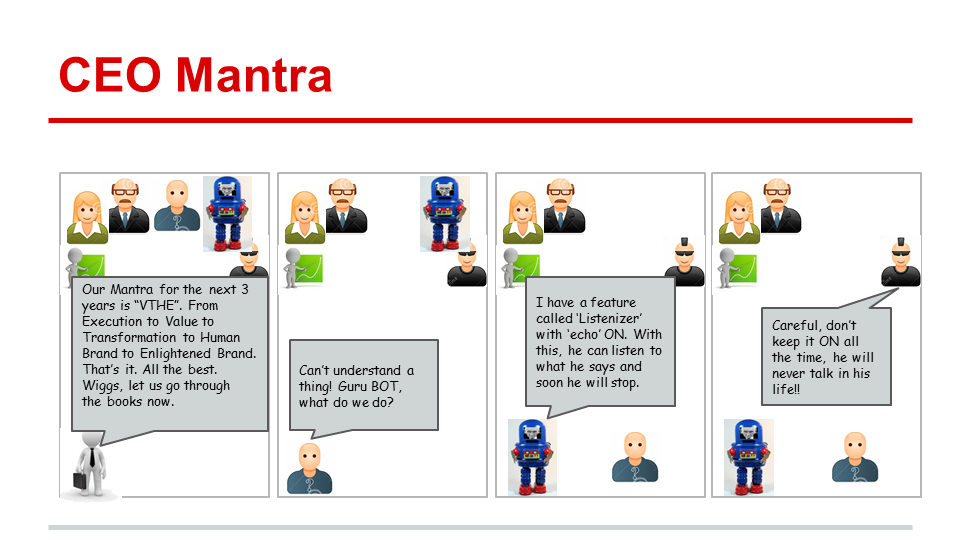
Intro
In the vast sea of knowledge, there’s a method of learning that stands out for its profound depth and authenticity: conversing with real people. While data and textbooks offer standardized insights, it’s in the nuanced conversations, the shared experiences, and the candid confessions where true understanding blooms. Why is this method unparalleled? Because every conversation is a unique tapestry of insights, woven together with threads of ‘Why’, ‘What’, and ‘How’. Whether you’re diving into the mind of an industry veteran or a bright-eyed newbie, the act of listening and documenting uncovers layers of understanding that other methods might miss. Join me as we explore the art of discovering and deciphering through conversations.
The Mindset of Absolute Listening:
Listening is an art, but listening without bias? That’s a superpower. Whether it’s a fresher just stepping into the field or a seasoned professional with decades under their belt, each conversation is a new opportunity for discovery. When we truly listen, without letting our experience or perceptions cloud our understanding, we open ourselves up to raw, unfiltered insights.
- Listen First: Start with the basics. Understand the ‘Why’, ‘What’, and ‘How’ of their work or experiences. These foundational questions can lead to a trove of knowledge, often uncovering facets you hadn’t considered.
- Know the Person: Before jumping to solutions or suggestions, it’s essential to understand who you’re talking to – their challenges, perspectives, and recommendations. This human-centric approach ensures that solutions and insights are relevant and actionable.
Capturing the Discovery:
Listening is just one half of the equation. The next crucial step? Capturing that newfound knowledge. While it might seem tedious, documenting these insights is invaluable.
- Mind Mapping: My go-to method. Mind maps offer a visual representation of ideas, showing connections and hierarchies. They’re an excellent tool for understanding complex topics or discussions.
- Documenting: While mind maps are great for visualization, sometimes you need a more detailed record. Converting these maps into documents provides a comprehensive view, ensuring no insight is lost.
- Note-Taking: For quicker sessions or when on-the-go, simple notes can do the trick. And with my speedy typing skills (a talent I recommend everyone in the digital age hone), I can quickly jot down crucial points.
- Leveraging AI: In this digital era, AI tools like ChatGPT have been game changers. They can help summarize conversations, extract key points, and even suggest follow-up questions. A blend of human insight and AI efficiency often leads to the best results.
Examples:
Diving into practical applications, here are a few examples to illuminate the breadth of understanding one can achieve through conversations. While these are just the tip of the iceberg, they offer a glimpse into the myriad possibilities:
- Industry: Conversations with an automobile veteran reveal the evolution of car designs and challenges of green technologies.
- Technology: Chatting with a software engineer illuminates the intricacies of AI algorithms and their ethical considerations.
- Process: Speaking to a barista provides a glimpse into the journey of coffee, from bean sourcing to brewing.
- Science: Engagement with a geneticist sheds light on the marvels and ethics of CRISPR technology.
- Management: Interacting with a project manager offers insights into team dynamics and resource allocation.
- Motivation Aspects: Listening to a sports coach reveals techniques for motivation and team spirit maintenance.
- Leadership: A session with a CEO uncovers the vision driving a company and the nuances of leadership.
- Concept: Discussion with a designer explains the essence of minimalism and its modern applications.
- Philosophy: Engagement with a philosophy professor deepens understanding of existentialism and its contemporary relevance.
- Psychology: Conversing with a psychologist provides insights into human behavior, underlying motives, and cognitive processes.
Contrarian Views
All methods of learning have their strengths and potential drawbacks or limitations. Here are some contrarian views or criticisms that might arise regarding this method of “Discovering and Deciphering through Conversations”:
- Subjectivity Over Objectivity: Some might argue that relying heavily on personal conversations might lead to a skewed perspective. Conversations, by nature, are subjective and may not always present a balanced view of a topic.
- Potential for Misinformation: Not everyone we converse with might have accurate or up-to-date information. There’s a risk of obtaining and internalizing misconceptions.
- Time-Intensive: Engaging in deep conversations and documenting them is time-consuming. Some might argue that reading a comprehensive article or attending a structured course could be more efficient.
- Limited Scope: Even the most experienced individual can only share from their range of experiences. This method might not provide a comprehensive or global perspective on a subject.
- Recall Bias: Memory is imperfect. When relying on people’s recollections, there’s a chance that some details might be forgotten, exaggerated, or misrepresented.
- Dependency on Availability: The method depends on finding willing and knowledgeable participants. Not everyone might be accessible or open to such conversations.
- Interpersonal Dynamics: Our personal biases, emotions, and the dynamics of a conversation can affect the information exchange. A participant’s willingness to share might be influenced by power dynamics, cultural norms, or personal rapport.
- Overwhelming Amount of Data: Sifting through extensive conversational data to pinpoint key insights can be daunting, especially without a structured approach.
It’s essential to recognize that no single method of learning is foolproof. While conversations offer rich, qualitative insights, it’s beneficial to supplement them with other forms of research and learning to ensure a well-rounded understanding.
MidJourney Prompt with inputs from ChatGPT
Create an illustration showcasing a diverse group of people engaged in deep conversation. Overlay this with symbolic elements representing the areas of Industry, Technology, Process, Science, Management, Motivation, Leadership, Concept, Philosophy, and Psychology. These symbols could include things like a gear (industry), a microchip (technology), a coffee cup (process), DNA helix (science), a team hierarchy chart (management), a motivational quote in a bubble (motivation), a guiding light or compass (leadership), a minimalistic design (concept), a Yin-Yang or question mark (philosophy), and a brain or thought bubble (psychology). Ensure the illustration has a harmonious, interconnected vibe, emphasizing the flow of ideas and understanding. –ar 16:9










